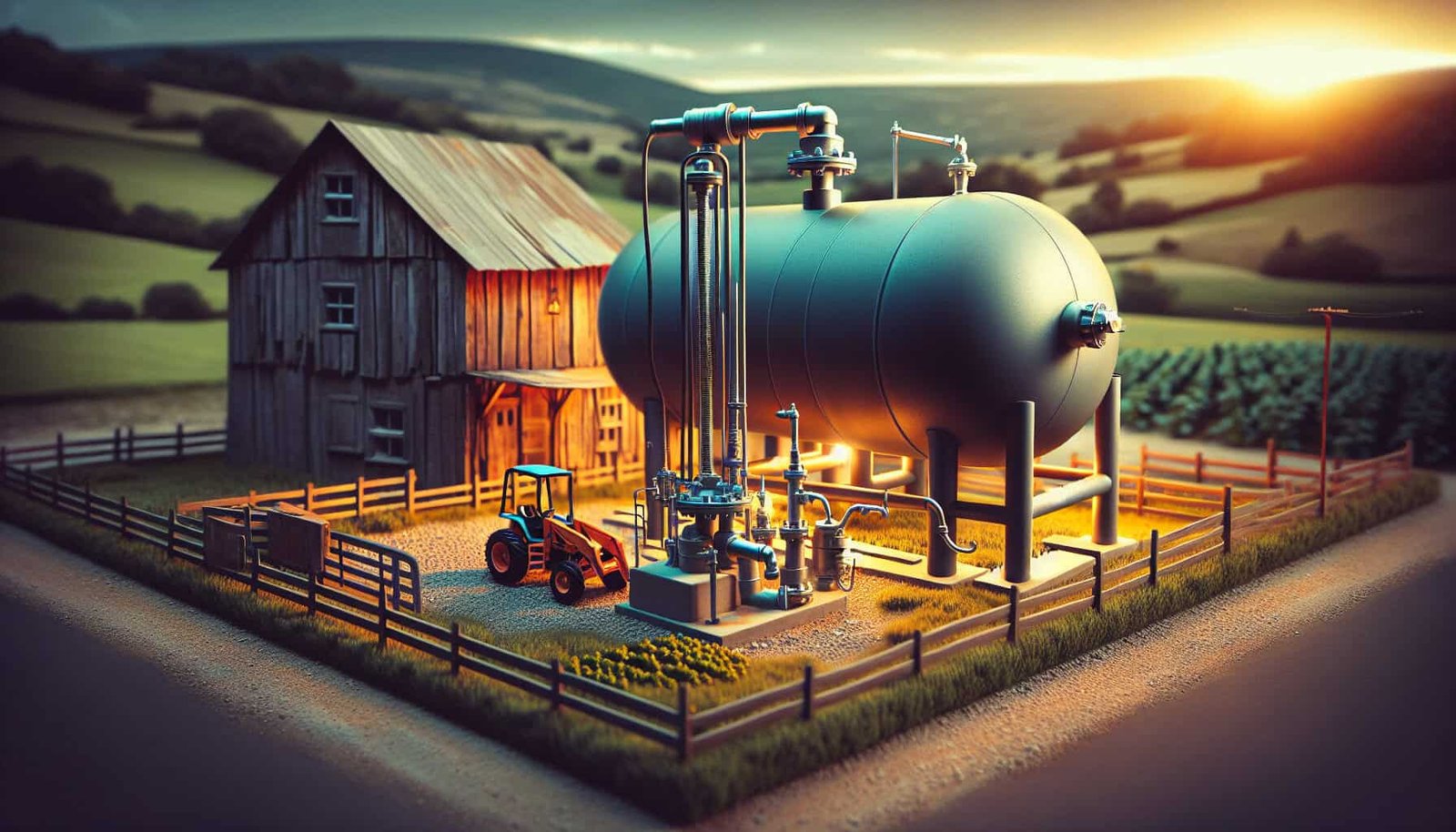Are you concerned about the safety of your well water due to issues related to well water pressure tank sizing? If so, it’s crucial to understand the importance of protecting your well water from any potential safety risks. A properly sized pressure tank plays a crucial role in maintaining water quality and preventing issues like bacterial growth, water contamination, and equipment damage. In this article, we will explore some effective measures that you can take to safeguard your well water and ensure its safety, while also addressing the crucial aspect of well water pressure tank sizing.

Understanding Well Water Pressure Tank Sizing
What is a well water pressure tank?
A well water pressure tank is an essential component of a well water system. It is designed to store pressurized water, which is used to supply water to various appliances and fixtures throughout your home. The tank works by using a diaphragm or bladder to separate the water and air, allowing for a constant and consistent water pressure.
Importance of proper well water pressure tank sizing
Proper well water pressure tank sizing is crucial for the efficient operation of your well water system. When the pressure tank is sized correctly, it ensures that the water demand in your home is met without putting excessive strain on the pump. This means that the pump doesn’t need to run as frequently, leading to energy conservation and prolonging the lifespan of the pump. Incorrect sizing, on the other hand, can have several negative consequences that may impact the performance and safety of your water system.
Consequences of incorrect sizing
If the well water pressure tank is undersized, it can result in frequent cycling of the pump, known as short cycling. Short cycling puts unnecessary stress on the pump, leading to faster wear and tear, and ultimately reducing its lifespan. Additionally, an undersized tank may not be able to meet the water demand in your home during peak usage times, resulting in reduced water pressure and inconvenience. On the other hand, an oversized tank can lead to decreased water pressure and increased energy consumption. It can also create potential safety issues, including the risk of water contamination and the formation of bacteria.
Factors to Consider for Well Water Pressure Tank Sizing
Water demand
To determine the appropriate size for your well water pressure tank, you need to consider the water demand in your home. This includes the number of appliances and fixtures that require water, as well as their flow rates. Factors such as the number of bathrooms, laundry machines, outdoor sprinkler systems, and dishwashers should all be taken into account.
Pump capacity
The capacity of your pump is another crucial factor in determining the size of your well water pressure tank. The pump capacity refers to the amount of water the pump can deliver within a given time frame, typically measured in gallons per minute (GPM). The tank should be sized to match or slightly exceed the pump’s capacity to ensure efficient operation.
Water pressure requirements
Understanding the desired water pressure in your home is important when sizing your pressure tank. Different appliances and fixtures may have specific water pressure requirements, and it is crucial to ensure that the pressure tank can maintain adequate water pressure to meet these needs. The ideal pressure range is typically between 40 and 60 pounds per square inch (PSI).
Available space
The physical space available for the installation of the pressure tank is a factor that cannot be overlooked. It is essential to choose a tank size that fits within the designated space while also allowing for proper installation, maintenance, and access to essential components. Taking accurate measurements of the available space will help determine the appropriate tank size.
Other specific needs
Every home is unique, and there may be additional factors that need to be considered when sizing a well water pressure tank. If you have specific requirements or unique fixtures, such as high-flow showerheads or specialized water treatment systems, it is crucial to communicate these needs to the professional assisting with the sizing process.
Calculating the Ideal Well Water Pressure Tank Size
Determining required drawdown
The drawdown is the amount of water that is drawn from the pressure tank before the pump kicks on to replenish the water supply. To determine the required drawdown, you can use a formula that incorporates the flow rate of the pump and the desired time to refill the tank. The drawdown should be sufficient to meet the water demand during peak usage times without causing excessive cycling of the pump.
Calculating required tank volume
Once the required drawdown is determined, it can be used to calculate the required volume of the pressure tank. The tank volume should be able to hold the desired drawdown amount without exceeding the available space and ensuring proper operation of the well water system. It is important to note that larger tank volumes generally result in less frequent cycling of the pump and more stable water pressure.
Considerations for multiple appliances or fixtures
If your home has multiple appliances or fixtures that require water simultaneously, it is necessary to account for their collective water demand. While it may not be feasible to size the pressure tank to accommodate the peak demand of all appliances, it is important to ensure that it can meet the minimum requirements during simultaneous usage. This can be achieved by consulting with a professional who can provide guidance on appropriate sizing based on the specific needs of your home.
Professional assistance for accurate calculations
Sizing a well water pressure tank accurately requires careful consideration of various factors and calculations. To ensure optimal performance, it is highly recommended to seek the assistance of a professional. They will have the expertise and experience to accurately assess your water system’s needs and determine the appropriate tank size based on those requirements.
Selecting the Appropriate Well Water Pressure Tank
Types of well water pressure tanks
There are two main types of well water pressure tanks: diaphragm tanks and bladder tanks. Diaphragm tanks use a rubber diaphragm to separate the water and air, while bladder tanks utilize a flexible bladder. Both types work effectively and provide the necessary separation to maintain consistent water pressure.
Capacity options available
Well water pressure tanks come in various capacities, typically ranging from 20 to 120 gallons. The appropriate capacity for your home will depend on factors such as water demand, pump capacity, and space availability. It is crucial to choose a tank capacity that can adequately supply water to your appliances and fixtures without causing excessive strain on the pump or compromising water pressure.
Considerations for material and durability
When selecting a well water pressure tank, it is important to consider the material and durability. Tanks are commonly made of steel or composite materials. Steel tanks are durable but are prone to rusting over time. Composite tanks are lighter, corrosion-resistant, and generally have a longer lifespan. It is essential to choose a tank material that suits your specific needs and offers long-term durability.
Brands and manufacturers to consider
There are several reputable brands and manufacturers that offer reliable and high-quality well water pressure tanks. Some well-known brands in the industry include Amtrol, Flexcon Industries, and Well-X-Trol. These brands are known for their durability, performance, and customer satisfaction. It is recommended to research and consider different brands when selecting a pressure tank to ensure you find the best option for your needs.

Installation and Maintenance Tips
Proper installation of the pressure tank
Proper installation of the pressure tank is crucial to ensure its optimal performance and longevity. It is recommended to hire a professional to install the tank, as they have the knowledge and expertise to ensure correct placement, secure connections, and proper alignment. Improper installation can result in leaks, loss of water pressure, and potential safety hazards.
Essential components and fittings
When installing a well water pressure tank, it is important to include essential components and fittings to ensure proper operation. This includes a pressure switch, pressure relief valve, pressure gauge, and check valve. These components work together to regulate the water pressure, monitor system performance, and ensure safety. It is essential to follow the manufacturer’s recommendations and consult with a professional to ensure the correct installation of these components.
Pressure switch adjustment
The pressure switch is a critical component that controls when the pump turns on and off based on the water pressure in the tank. It is important to adjust the pressure switch properly to ensure that the pump operates within the desired pressure range. Consult with a professional to determine the appropriate pressure setting for your specific well water system.
Regular inspection and maintenance
Regular inspection and maintenance of the well water pressure tank are essential to ensure optimal performance and safety. This includes checking for any signs of leaks, monitoring the water pressure, and inspecting the tank for any corrosion or damage. It is recommended to have a professional inspect and maintain your well water system on a regular basis to identify and address any potential issues before they escalate.
Common Safety Issues Associated with Incorrect Sizing
Short cycling
Short cycling is a common safety issue associated with an undersized well water pressure tank. It occurs when the tank is unable to hold an adequate amount of water to meet the demand, resulting in frequent and rapid cycling of the pump. This puts excessive strain on the pump, leading to increased wear and tear and a shorter lifespan.
Decreased pump lifespan
When the well water pressure tank is not sized correctly, the pump may be forced to run more frequently to meet the water demand. This increased workload can result in decreased pump lifespan, as it is subjected to more wear and tear. A pump replacement can be costly and inconvenient, making proper tank sizing essential for avoiding premature pump failure.
Reduced water pressure
If the well water pressure tank is undersized, it may not be able to supply enough water during peak demand, resulting in reduced water pressure. This can be particularly problematic when multiple appliances or fixtures require water simultaneously, leading to inconvenience and inefficient water usage.
Increased energy consumption
An oversized well water pressure tank can result in increased energy consumption. When the tank is too large, the pump cycles less frequently, but for longer durations. This constant on-off cycling can lead to unnecessary energy usage, resulting in higher electricity bills. Sizing the tank correctly can help optimize energy efficiency and reduce energy consumption.
Potential for water contamination
When a well water pressure tank is not sized appropriately, it can create conditions that facilitate water contamination. An undersized tank may cause bacteria growth due to stagnant water, while an oversized tank can lead to water stagnation and potential breeding grounds for harmful bacteria. Ensuring proper tank sizing helps maintain the quality and safety of your well water supply.

How to Prevent Safety Issues
Getting a professional well water system evaluation
To prevent safety issues associated with well water pressure tank sizing, it is highly recommended to get a professional well water system evaluation. A professional can assess the specific needs of your home, including water demand, pump capacity, and plumbing specifications. By conducting a thorough evaluation, they can provide an accurate assessment and recommend the appropriate tank size for your well water system.
Sizing the pressure tank correctly
Proper sizing of the well water pressure tank is crucial for preventing safety issues. By considering factors such as water demand, pump capacity, and available space, you can ensure that the tank is adequately sized to meet your home’s water requirements without compromising performance or safety. Consulting with a professional will help ensure accurate calculations and proper sizing.
Regular system monitoring and maintenance
Regular monitoring and maintenance of your well water system are essential for preventing safety issues. This includes checking water pressure, inspecting the tank for leaks or damage, and addressing any issues promptly. By staying proactive and vigilant, you can identify and resolve any potential problems before they escalate, ensuring the ongoing safety and reliability of your well water system.
Promptly addressing any issues
If you notice any abnormalities or issues with your well water pressure tank, it is important to address them promptly. Delaying repairs or maintenance can lead to further damage or safety hazards. If you are unsure about how to address an issue, it is recommended to consult with a professional who can provide expert guidance and assistance.
Importance of Hiring a Professional
Experience and expertise in well water systems
Hiring a professional with experience and expertise in well water systems is crucial for ensuring the optimal performance and safety of your well water pressure tank. They have a deep understanding of the intricacies of well water systems and can accurately assess your specific needs to recommend the appropriate tank size.
Accurate assessment and calculations
Sizing a well water pressure tank requires accurate assessment and calculations. A professional has the knowledge and tools to accurately determine factors such as water demand, pump capacity, and available space. By relying on their expertise, you can have confidence that the tank size will be correctly determined to meet the specific requirements of your well water system.
Ensuring compliant installation
Improper installation of a well water pressure tank can lead to safety hazards and inefficiencies. Hiring a professional ensures that the tank is installed correctly and complies with industry standards and regulations. They have the skills and knowledge to handle the installation process properly, including connecting essential components and fittings.
Long-term reliability and safety
By hiring a professional, you can ensure long-term reliability and safety for your well water system. Professional installation, accurate sizing, and regular maintenance can help prevent safety issues and extend the lifespan of your well water pressure tank and pump. Investing in professional assistance provides peace of mind and protects your investment in your water system.

Additional Considerations for Well Water Safety
Water quality testing
Well water safety goes beyond just pressure tank sizing. It is important to regularly test the quality of your well water to ensure it is safe for consumption. Testing can help identify any potential contaminants or issues with water quality, allowing you to take appropriate measures such as water treatment or filtration systems.
Water treatment options
Depending on the quality of your well water, you may need to consider water treatment options to improve its safety and taste. Water treatment systems, such as filters, softeners, or UV sterilizers, can help remove impurities, bacteria, and other contaminants from your well water. Consulting with a professional can help determine the most appropriate treatment options for your specific needs.
Protecting against contaminants
Protecting your well water from potential contaminants is crucial for maintaining safety. It is important to ensure that your well is properly sealed and protected from any sources of contamination, such as chemicals, fertilizers, or waste materials. Regular inspections and maintenance of your well can help identify and address any potential risks.
Monitoring water usage patterns
Monitoring your water usage patterns can provide valuable insight into the performance and efficiency of your well water system. Observing usage trends and identifying any sudden changes in water consumption can help detect potential issues, such as leaks or malfunctions, before they escalate. By staying aware of your water usage patterns, you can take proactive measures to maintain the safety and efficiency of your well water system.
Conclusion
Proper well water pressure tank sizing is essential for ensuring the optimal performance, efficiency, and safety of your well water system. By considering factors such as water demand, pump capacity, and available space, you can determine the appropriate tank size that meets the specific needs of your home. Professional assistance is highly recommended to accurately assess your well water system, calculate the ideal tank size, and ensure compliant installation. Regular monitoring and maintenance, along with proper water quality testing and treatment, will ensure the ongoing safety and reliability of your well water system. By prioritizing well water safety and choosing professional expertise, you can protect your well water from safety issues associated with well water pressure tank sizing.


